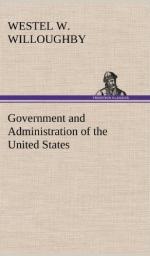We have seen that the functions of government are divided into three distinct classes, the legislative, the judicial, and the executive. The Constitution provides as to the methods for the exercise of the first two, but none for the third. The only reference in the constitution to executive departments is in Art. II, Sec. 2, where the President is given the power to require the opinion in writing of the principal officer in each executive department upon any subject relating to the duties of his office. The departments have in each case been created by an act of Congress and from time to time as convenience has demanded.
The duties of the executive are to enforce and apply the laws of the nation after they are made by the legislature and interpreted by the courts. This is the real business of government, by which the laws are put into effect, and the work of government is actually carried on. In the United States Government this power is placed in the hands of a body of men distinct from the legislative and judicial officers. At the head is the President, and hence his title of “Chief Executive.” It is evident that he must divide up the vast amount of work to be done, and delegate it to others. Congress directs how this shall be done. For this purpose Congress has created nine executive departments (1)State, (2)Treasury, (3)War, (4)Navy, (5)Interior, (6)Post Office, (7)Justice, (8)Agriculture, (9)Labor.
These departments have been created as required by the growth of government duties. Three departments, the State, Treasury and War, were created by the first Congress, in 1789. By the same Congress was created the office of Attorney-General of the United States, who, together with the Secretaries of the three departments, constituted President Washington’s first cabinet. The Navy Department was added in 1798. Prior to that date, naval affairs had been managed by the War Department. A Post Office for the colonies was established by the Postal Act of Queen Anne’s reign. The Post Office Department under the present government was established in 1789, but the Postmaster-General did not become a Cabinet officer until 1829. The Interior Department was created in 1849 by grouping together in one department several branches of the government service, which had formerly been distributed among the other departments. As early as 1839 the Patent Office, under the Interior Department, was intrusted with various duties concerning the agricultural interests of the country, among the chief of which was the distribution of seeds. In 1862 a separate Department of Agriculture was established, and these duties transferred to it. In 1889 the head of the Department became Secretary of the Department of Agriculture and a Cabinet officer. A Bureau of Labor under the Interior Department was created in 1884. In 1888 Congress constituted it a separate department, but did not make its head a Secretary, and therefore not a Cabinet officer.




